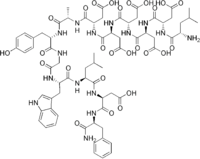Minigastrin
Minigastrin (also mini gastrin) is a form of gastrin. Its sequence is H-Leu-Glu-Glu-Glu-Glu-Glu-Ala-Tyr-Gly-Trp-Met-Asp-Phe-NH2.[1]
 | |
| Identifiers | |
|---|---|
3D model (JSmol) |
|
| ChemSpider | |
PubChem CID |
|
| UNII | |
CompTox Dashboard (EPA) |
|
| |
| |
| Properties | |
| C70H91N15O26 | |
| Molar mass | 1558.56 g/mol |
Except where otherwise noted, data are given for materials in their standard state (at 25 °C [77 °F], 100 kPa). | |
| Infobox references | |
Minigastrin has shown to be a potential therapeutic agent for thyroid carcinoma by targeting cancer-promoting cholecystokinin receptors[2] A 2018 study further elaborates by using radiochemical labeling to show that Indium-111 labeled minigastrin peptides showing to have stronger affinity to cholecystokinin B receptors (CCK2) in neuroendocrine cancers.[3]
References
- Oxford dictionary of biochemistry and molecular biology (Rev. ed.). Oxford University Press. ISBN 9780198529170.
- von Guggenberg, Elisabeth; Rangger, Christine; Sosabowski, Jane; Laverman, Peter; Reubi, Jean-Claude; Virgolini, Irene Johanna; Decristoforo, Clemens (6 July 2011). "Preclinical Evaluation of Radiolabeled DOTA-Derivatized Cyclic Minigastrin Analogs for Targeting Cholecystokinin Receptor Expressing Malignancies". Molecular Imaging and Biology. 14 (3): 366–375. doi:10.1007/s11307-011-0506-2.
- Rizvi, Syed Faheem Askari; Naqvi, Syed Ali Raza; Roohi, Samina; Sherazi, Tauqir A.; Rasheed, Rashid (24 August 2018). "177Lu-DOTA-coupled minigastrin peptides: promising theranostic agents in neuroendocrine cancers". Molecular Biology Reports. 45 (6): 1759–1767. doi:10.1007/s11033-018-4319-0.
This article is issued from Wikipedia. The text is licensed under Creative Commons - Attribution - Sharealike. Additional terms may apply for the media files.